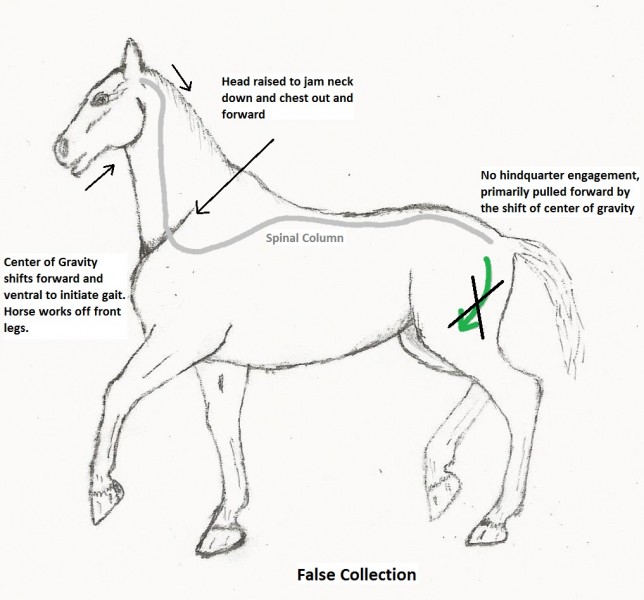Equine False Collection is more common then most owners or trainers think and is detrimental to your horse’s musculoskeletal system and gait performance. A common cause of equine lameness issues, Equine False Collection is abnormal musculoskeletal bio-mechanics. The abnormal bio-mechanical movement of the horse will result in abnormal tension, strain, and force on your horse’s tendons, ligaments, bones, and joints. These abnormal forces produce inflammation, arthritis, trauma and breakdown or lameness in your horse. With Equine False Collection, medical expenses and lay off time increases. Loss of intended function can even occur as a result of Equine False Collection. We should do all we can to improve the health and function of our equine friends by correcting and preventing Equine False Collection.

What is Equine False Collection?
To understand it, you need to have an understanding of true equine gait collection as discussed in detail in previous blog posts “Equine Biomechanics of Locomotion” and “Equine Gait Collection“. In order to create locomotion the center of gravity of the horse has to be moved forward. In general terms the horse is a rear driven animal with the power for locomotion starting in the hind legs, moving through the pelvis to the spine and forequarters. The front legs act more in a power steering function verses a power generating function.
In regards to false collection, the hindquarters are partially or completely disengaged. Therefore, the hindquarters are not providing the required power to move the center of gravity forward. As we ask the horse to preform they must now figure out a new abnormal method to move the center of gravity forward. The horse accomplishes this by raising his head to push his chest forward initiating movement of the center of gravity. When the head raises and pulls toward the tail, the lower neck or cervical vertebra and the first couple of thoracic vertebra are compressed together. This causes the chest to be pushed down and forward over the fore leg column. As the mass of the horse falls over the fore leg column, the horse uses gravity to initiate motion and attempts to pull the body forward with his front legs. In the process, the hind quarters follow along or provide minimal amount of propulsion to move the horse’s center of gravity. In essence, the horse has shifted his center of gravity by falling over his front legs to start the gait and then uses his hind legs to catch up with the body.
How is False Collection detrimental to my horse?
With Equine False Collection the horse’s bio-mechanical function has changed. The musculoskeletal structure and function take on a different orientation then designed. Since hindquarters are not moving bio-mechanically correct or are in pain. The horse disengages or reduces the function of the hindquarters. Therefore the movement of the chest forward initiates movement of the center of gravity of the horse. The horse uses his chest, head, neck and forequarters to propagate the momentum for movement. The hindquarters are pulled along or provide minimal propulsion. Equine False Collection is a result of decreased hind leg propulsion and an attempted increase foreleg pulling.
False Collection produces abnormal motion of the cervical and thoracic vertebra, increasing compression on the cervical and first few thoracic spinal nerves. This body arrangement compounds strains on the bones, muscles, tendons, ligaments and joints of the fore legs. With the reduced nerve impulse, weak muscles are produced in both the forequarters and hindquarters resulting in less leg joint stability or increase in joint laxity or motion, along with increased tendon and ligament forces and strain. Therefore, common disease processes like bowed tendons, joint swelling and heat, ligament strains, navicular syndrome, arthritis and degenerative joint disease can occur in your horse due to weak muscles and resulting joint laxity produced by decrease nerve function.
What can we do?
As you can see, the need for correct bio-mechanical function and true collection is paramount in maintaining your horses soundness and maximizing athletic function. With correct bio-mechanical locomotion and spinal motion, nerve function is maximized. Normal nerve function produces strong muscles thereby relieving unnecessary tendon and ligament strain and stabilizing or securing the leg joints. Correct bio-mechanical function and spinal motion of the horse can be obtained with Applied Kinesiology directed Chiropractic Manipulation. With a basic understanding of equine biomechanics, we will discuss equine lameness in the fourth and last blog of this series – “Equine Lameness – Is it preventable?”

[…] Wagner, K., 2016. Equine False Collection. Keith Wagner Equine Veterinarian [online]. Available: https://wagnerhorsedoc.com/equine-false-collection/ [accessed 14/4/2022] [8] Equicore Concepts, n.d. User Guide [online]. Available: […]